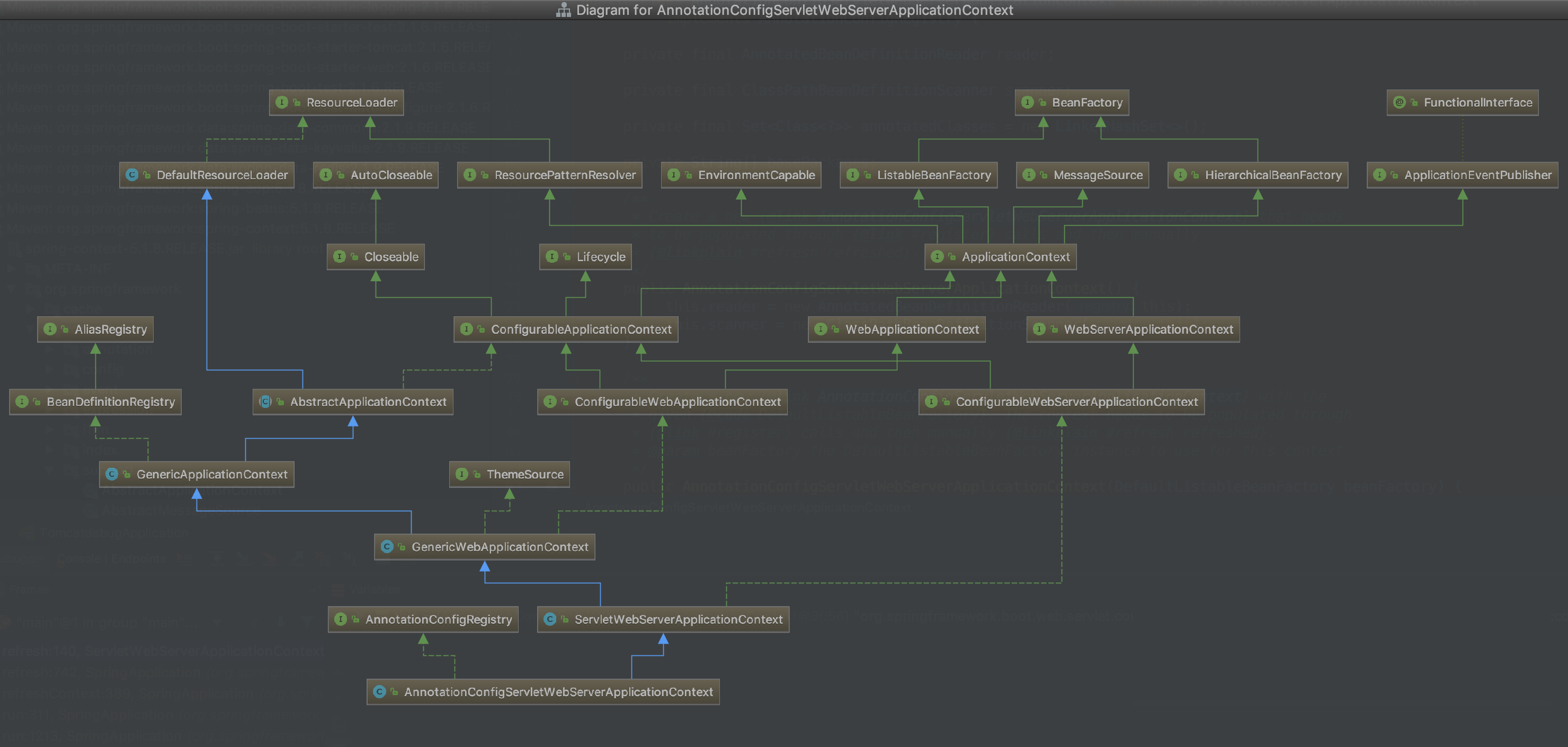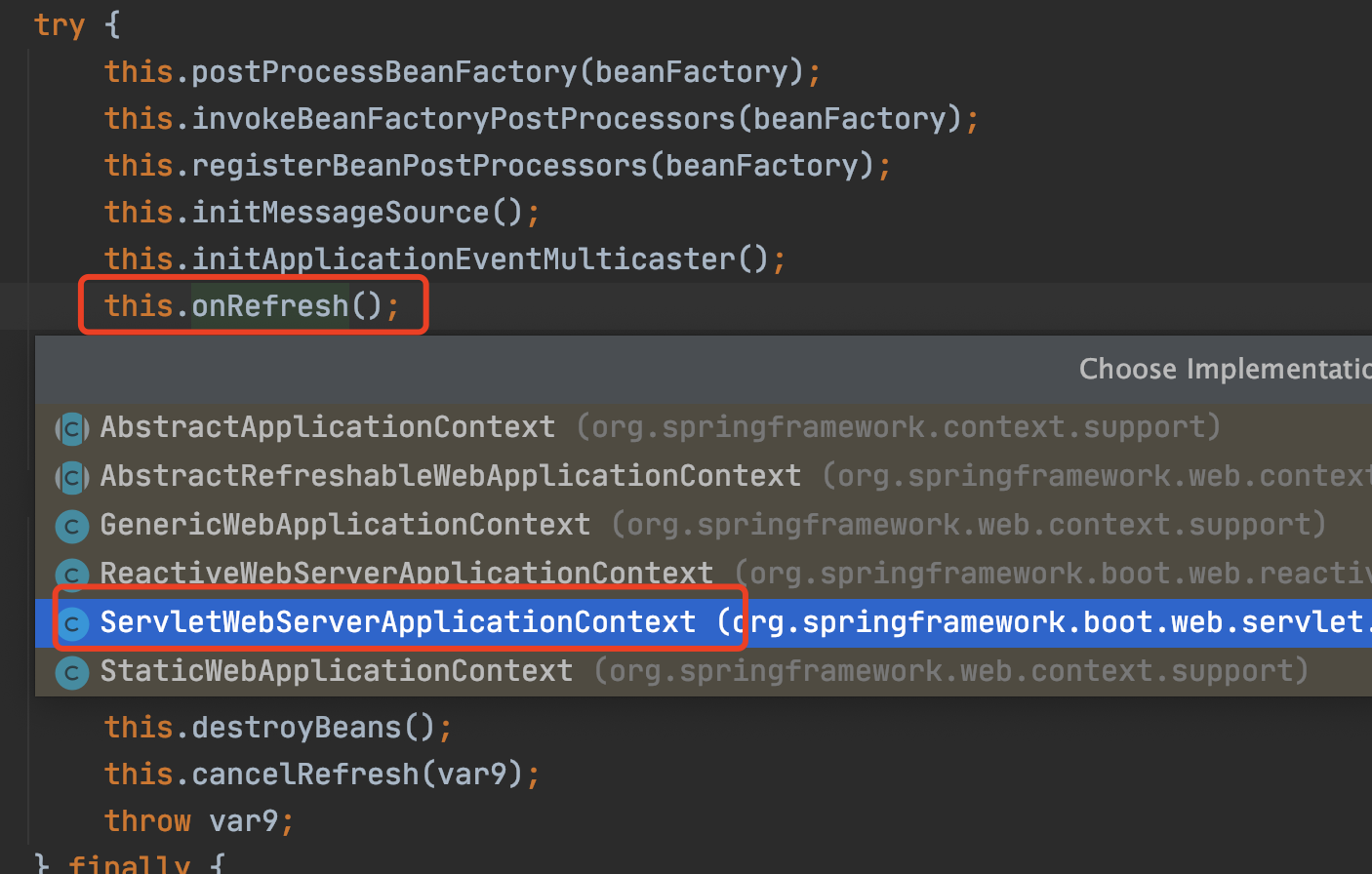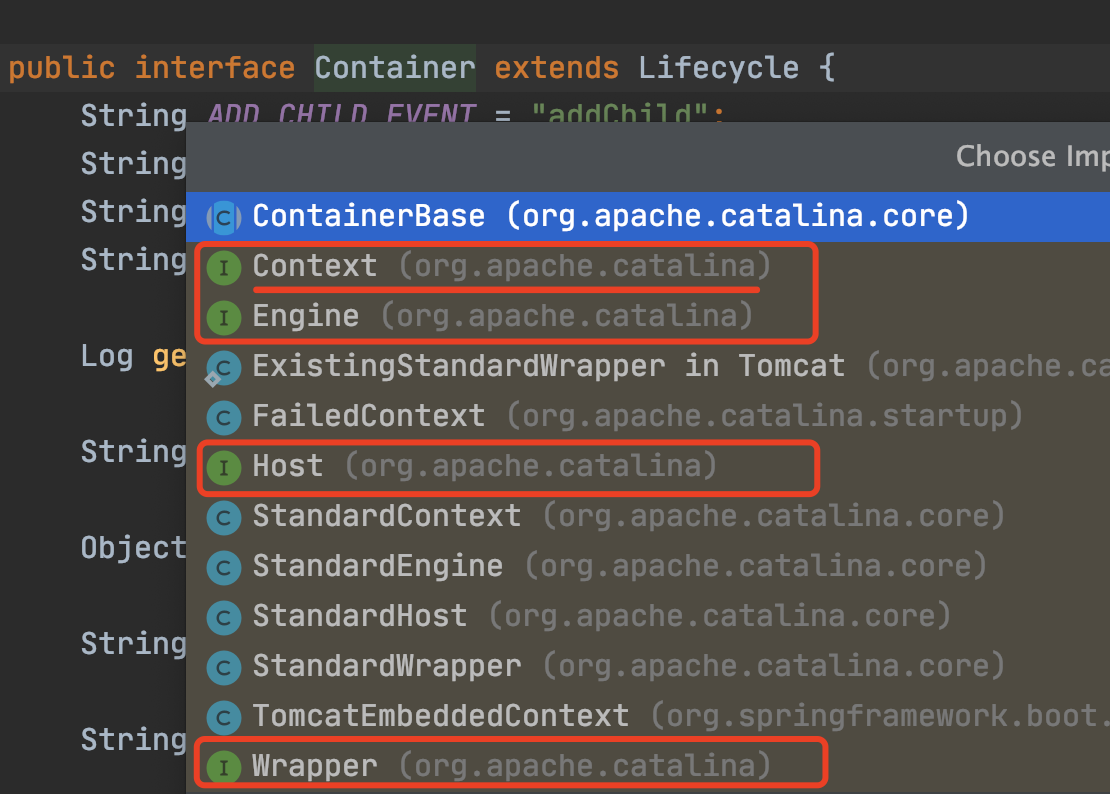<dependency><groupId>org.springframework.boot</groupId><artifactId>spring-boot-starter-web</artifactId>
</dependency>
添加如上 Web 的依赖,Spring Boot 就帮我们内置了 Servlet 容器,默认使用的是 Tomcat,同样也支持修改,比如可以使用 jetty、Undertow 等。
因为内置了启动容器,应用程序可以直接通过 Maven 命令将项目编译成可执行的 jar 包,通过 java -jar 命令直接启动,不需要再像以前一样,打包成 War 包,然后部署在 Tomcat 中。
那么:你知道内置的 Tomcat 在 Spring Boot 中是怎么启动的吗?
从启动入口分析
如果不知道从哪开始,那么至少应该知道 Spring Boot 其实运行的就是一个 main 方法,
本文环境:Spring Boot:2.2.2.RELEASE
@SpringBootApplication
public class MyApplication {public static void main(String[] args) {SpringApplication.run(MyApplication.class, args);}
}
我们点进这个 SpringApplication.run() 方法:
public static ConfigurableApplicationContext run(Class<?> primarySource, String... args) {return run(new Class[]{primarySource}, args);
}
这列的 run() 方法返回的是 ConfigurableApplicationContext 对象,我们继续跟踪这个 run() 方法:
public static ConfigurableApplicationContext run(Class<?>[] primarySources, String[] args) {return (new SpringApplication(primarySources)).run(args);
}
又套了一层,继续点击这个返回的 run() 方法:
public ConfigurableApplicationContext run(String... args) {StopWatch stopWatch = new StopWatch();stopWatch.start();ConfigurableApplicationContext context = null;Collection<SpringBootExceptionReporter> exceptionReporters = new ArrayList<>();/** 1、配置属性* 设置系统属性 java.awt.headless,为 true 则启用headless模式* headless模式是应用的一种配置模式,在服务器缺少显示设备、键盘、鼠标等外设的情况下可以使用该模式* 比如我们使用的Linux服务器就是缺少前述的这些设备,但是又需要使用这些设备提供的能力*/configureHeadlessProperty();/** 2、获取监听器,发布应用开始启动事件* 通过SpringFactoriesLoader检索META-INF/spring.factories,* 找到声明的所有SpringApplicationRunListener的实现类并将其实例化,* 之后逐个调用其started()方法,广播SpringBoot要开始执行了*/SpringApplicationRunListeners listeners = getRunListeners(args);/* 发布应用开始启动事件 */listeners.starting();try {/* 3、初始化参数 */ApplicationArguments applicationArguments = new DefaultApplicationArguments(args);/** 4、配置环境,输出banner* 创建并配置当前SpringBoot应用将要使用的Environment(包括配置要使用的PropertySource以及Profile),* 并遍历调用所有的SpringApplicationRunListener的environmentPrepared()方法,广播Environment准备完毕。*/ConfigurableEnvironment environment = prepareEnvironment(listeners,applicationArguments);configureIgnoreBeanInfo(environment);/* 打印banner,如果在resources目录下创建了我们自己的banner就会进行打印,否则默认使用spring的 */Banner printedBanner = printBanner(environment);/* 5、创建应用上下文 */context = createApplicationContext();/* 通过SpringFactoriesLoader检索META-INF/spring.factories,获取并实例化异常分析器。 */exceptionReporters = getSpringFactoriesInstances(SpringBootExceptionReporter.class,new Class[] { ConfigurableApplicationContext.class }, context);/** 6、预处理上下文* 为ApplicationContext加载environment,之后逐个执行ApplicationContextInitializer的initialize()方法来进一步封装ApplicationContext,* 并调用所有的SpringApplicationRunListener的contextPrepared()方法,【EventPublishingRunListener只提供了一个空的contextPrepared()方法】,* 之后初始化IoC容器,并调用SpringApplicationRunListener的contextLoaded()方法,广播ApplicationContext的IoC加载完成,* 这里就包括通过@EnableAutoConfiguration导入的各种自动配置类。*/prepareContext(context, environment, listeners, applicationArguments,printedBanner);/* 7、刷新上下文 */refreshContext(context);/* 8、再一次刷新上下文,其实是空方法,可能是为了后续扩展。 */afterRefresh(context, applicationArguments);stopWatch.stop();if (this.logStartupInfo) {new StartupInfoLogger(this.mainApplicationClass).logStarted(getApplicationLog(), stopWatch);}/* 9、发布应用已经启动的事件 */listeners.started(context);/** 遍历所有注册的ApplicationRunner和CommandLineRunner,并执行其run()方法。* 我们可以实现自己的ApplicationRunner或者CommandLineRunner,来对SpringBoot的启动过程进行扩展。*/callRunners(context, applicationArguments);}catch (Throwable ex) {handleRunFailure(context, ex, exceptionReporters, listeners);throw new IllegalStateException(ex);}try {/* 10、发布应用已经启动完成的监听事件 */listeners.running(context);}catch (Throwable ex) {handleRunFailure(context, ex, exceptionReporters, null);throw new IllegalStateException(ex);}return context;
}
如果觉得这个方法看的云里雾里的,那么可以概括为如下几步:
- 配置系统属性
- 获取监听,发布应用开始启动时间
- 初始化输入参数
- 配置环境,输出banner
- 创建上下文
- 预处理上下文
- 刷新上下文
- 再次刷新上下文
- 发布应用已经启动事件
- 发布应用启动完成事件
而我们 Tomcat 的启动主要是在第5步创建上下文,以及第 7步刷新上下文实现的。
创建上下文
第5步中,创建上下文主要是调用的 createApplicationContext() 方法:
protected ConfigurableApplicationContext createApplicationContext() {/** 1. 根据Web应用类型,获取对应的ApplicationContext子类 **/Class<?> contextClass = this.applicationContextClass;if (contextClass == null) {try {switch(this.webApplicationType) {case SERVLET:contextClass = Class.forName("org.springframework.boot.web.servlet.context.AnnotationConfigServletWebServerApplicationContext");break;case REACTIVE:contextClass = Class.forName("org.springframework.boot.web.reactive.context.AnnotationConfigReactiveWebServerApplicationContext");break;default:contextClass = Class.forName("org.springframework.context.annotation.AnnotationConfigApplicationContext");}} catch (ClassNotFoundException var3) {throw new IllegalStateException("Unable create a default ApplicationContext, please specify an ApplicationContextClass", var3);}}/** 2. 实例化子类 **/return (ConfigurableApplicationContext)BeanUtils.instantiateClass(contextClass);
}
代码中主要就是通过 switch 语句,根据 webApplicationType 的类型来创建不同的 ApplicationContext:
- SERVLET:Web类型,实例化 AnnotationConfigServletWebServerApplicationContext
- REACTIVE:响应式Web类型,实例化 AnnotationConfigReactiveWebServerApplicationContext
- default:非Web类型,实例化 AnnotationConfigApplicationContext
因为我们的应用是 Web 类型,所以实例化的是 AnnotationConfigServletWebServerApplicationContext,如下是该类的关系图(由Diagram截图):

我们在上图的底部触发,可以看到 AnnotationConfigServletWebServerApplicationContext > ServletWebServerApplicationContext > … AbstractApplicationContext(>表示继承),总之,最终继承到了 AbstractApplicationContext,这个类是 ApplicationContext 的抽象实现类,该抽象类实现应用上下文的一些具体操作。
至此,并没有看到 Tomcat 的相关代码,其实这一步主要就是「创建上下文」,拿到「上下文」之后需要传递给「刷新上下文」,交由刷新上下文创建 Web 服务。
刷新上下文
第7步中,刷新上下文时调用的 refreshContext(context) 方法,其中 context 就是第5步创建的上下文,方法如下:
private void refreshContext(ConfigurableApplicationContext context) {refresh(context);if (this.registerShutdownHook) {try {context.registerShutdownHook();}catch (AccessControlException ex) {// Not allowed in some environments.}}
}protected void refresh(ApplicationContext applicationContext) {Assert.isInstanceOf(AbstractApplicationContext.class, applicationContext);((AbstractApplicationContext) applicationContext).refresh();
}
refreshContext() 方法传递的 context,经由 refresh() 方法强转成父类 AbstractApplicationContext,具体调用过程如下:
public void refresh() throws BeansException, IllegalStateException {synchronized(this.startupShutdownMonitor) {this.prepareRefresh();ConfigurableListableBeanFactory beanFactory = this.obtainFreshBeanFactory();this.prepareBeanFactory(beanFactory);try {this.postProcessBeanFactory(beanFactory);this.invokeBeanFactoryPostProcessors(beanFactory);this.registerBeanPostProcessors(beanFactory);this.initMessageSource();this.initApplicationEventMulticaster();/** 主要关系 onRefresh() 方法 ------------- **/this.onRefresh();this.registerListeners();this.finishBeanFactoryInitialization(beanFactory);this.finishRefresh();} catch (BeansException var9) {if (this.logger.isWarnEnabled()) {this.logger.warn("Exception encountered during context initialization - cancelling refresh attempt: " + var9);}this.destroyBeans();this.cancelRefresh(var9);throw var9;} finally {this.resetCommonCaches();}}
}
在这个方法中我们主要关心 onRefresh() 方法,onRefresh() 方法是调用其子类实现的,也就是 ServletWebServerApplicationContext,

如下是子类的 onRefresh() 方法:
protected void onRefresh() {super.onRefresh();try {this.createWebServer();} catch (Throwable var2) {throw new ApplicationContextException("Unable to start web server", var2);}
}private void createWebServer() {WebServer webServer = this.webServer;ServletContext servletContext = this.getServletContext();if (webServer == null && servletContext == null) {/** 得到Servlet工厂 **/ServletWebServerFactory factory = this.getWebServerFactory();this.webServer = factory.getWebServer(new ServletContextInitializer[]{this.getSelfInitializer()});} else if (servletContext != null) {try {this.getSelfInitializer().onStartup(servletContext);} catch (ServletException var4) {throw new ApplicationContextException("Cannot initialize servlet context", var4);}}this.initPropertySources();
}
其中 createWebServer() 方法是用来启动web服务的,但是还没有真正启动 Tomcat,只是通过ServletWebServerFactory 创建了一个 WebServer,我们继续来看这个 ServletWebServerFactory:

ServletWebServerFactory 有4个实现类,其中我们最常用的是 TomcatServletWebServerFactory和JettyServletWebServerFactory,而默认的 Web 环境就是 TomcatServletWebServerFactory。
而到这总算是看到 Tomcat 相关的字眼了。
来看一下 TomcatServletWebServerFactory 的 getWebServer() 方法:
public WebServer getWebServer(ServletContextInitializer... initializers) {if (this.disableMBeanRegistry) {Registry.disableRegistry();}/** 1、创建Tomcat实例 **/Tomcat tomcat = new Tomcat();File baseDir = this.baseDirectory != null ? this.baseDirectory : this.createTempDir("tomcat");tomcat.setBaseDir(baseDir.getAbsolutePath());Connector connector = new Connector(this.protocol);connector.setThrowOnFailure(true);tomcat.getService().addConnector(connector);this.customizeConnector(connector);/** 2、给创建好的tomcat设置连接器connector **/tomcat.setConnector(connector);/** 设置不自动部署 **/tomcat.getHost().setAutoDeploy(false);/** 3、配置Tomcat容器引擎 **/this.configureEngine(tomcat.getEngine());Iterator var5 = this.additionalTomcatConnectors.iterator();while(var5.hasNext()) {Connector additionalConnector = (Connector)var5.next();tomcat.getService().addConnector(additionalConnector);}/*** 准备Tomcat的StandardContext,并添加到Tomcat中,同时把initializers 注册到类型为* TomcatStarter的ServletContainerInitializer中**/this.prepareContext(tomcat.getHost(), initializers);/** 将创建好的Tomcat包装成WebServer返回**/return this.getTomcatWebServer(tomcat);
}public Engine getEngine() {Service service = this.getServer().findServices()[0];if (service.getContainer() != null) {return service.getContainer();} else {Engine engine = new StandardEngine();engine.setName("Tomcat");engine.setDefaultHost(this.hostname);engine.setRealm(this.createDefaultRealm());service.setContainer(engine);return engine;}
}
getWebServer() 这个方法创建了 Tomcat 对象,并且做了两件重要的事情:
- 把连接器 Connector 对象添加到 Tomcat 中;
- 配置容器引擎,configureEngine(tomcat.getEngine());
首先说一下这个 Connector 连接器,Tomcat 有两个核心功能:
- 处理 Socket 连接,负责网络字节流与 Request 和 Response 对象的转化。
- 加载和管理 Servlet,以及具体处理 Request 请求。
针对这两个功能,Tomcat 设计了两个核心组件来分别完成这两件事,即:连接器(Connector)和容器(Container)。
整个过程大致就是:Connector 连接器接收连接请求,创建Request和Response对象用于和请求端交换数据,然后分配线程让Engine(也就是Servlet容器)来处理这个请求,并把产生的Request和Response对象传给Engine。当Engine处理完请求后,也会通过Connector将响应返回给客户端。
这里面提到了 Engine,这个是 Tomcat 容器里的顶级容器(Container),我们可以通过 Container 类查看其他的子容器:Engine、Host、Context、Wrapper

4者的关系是:Engine 是最高级别的容器,Engine 子容器是 Host,Host 的子容器是 Context,Context 子容器是 Wrapper,所以这4个容器的关系就是父子关系,即:Wrapper > Context > Host > Engine (>表示继承)
至此我们了解了 Engine 这个就是个容器,然后我们再看一下这个 configureEngine(tomcat.getEngine()) 具体干了啥:
private void configureEngine(Engine engine) {engine.setBackgroundProcessorDelay(this.backgroundProcessorDelay);Iterator var2 = this.engineValves.iterator();while(var2.hasNext()) {Valve valve = (Valve)var2.next();engine.getPipeline().addValve(valve);}
}
其中 engine.setBackgroundProcessorDelay(this.backgroundProcessorDelay) 是指定背景线程的执行间隔,例如背景线程会在每隔多长时间后判断session是否失效之类。
再回到 getWebServer() 方法,最终 getWebServer() 方法返回了 TomcatWebServer。
return this.getTomcatWebServer(tomcat);
通过 getTomcatWebServer() 方法,继续下沉:
/*** 构造函数实例化 TomcatWebServer**/
public TomcatWebServer(Tomcat tomcat, boolean autoStart) {this.monitor = new Object();this.serviceConnectors = new HashMap();Assert.notNull(tomcat, "Tomcat Server must not be null");this.tomcat = tomcat;this.autoStart = autoStart;this.initialize();
}private void initialize() throws WebServerException {/** 我们在启动 Spring Boot 时经常看到打印这句话 **/logger.info("Tomcat initialized with port(s): " + this.getPortsDescription(false));synchronized(this.monitor) {try {this.addInstanceIdToEngineName();Context context = this.findContext();context.addLifecycleListener((event) -> {if (context.equals(event.getSource()) && "start".equals(event.getType())) {this.removeServiceConnectors();}});/** 启动 tomcat **/this.tomcat.start();this.rethrowDeferredStartupExceptions();try {ContextBindings.bindClassLoader(context, context.getNamingToken(), this.getClass().getClassLoader());} catch (NamingException var5) {}this.startDaemonAwaitThread();} catch (Exception var6) {this.stopSilently();this.destroySilently();throw new WebServerException("Unable to start embedded Tomcat", var6);}}
}
至此,Tomcat 启动过程就很清晰了,总结一下。
总结
SpringBoot的启动主要是通过实例化SpringApplication来启动的,启动过程主要做了如下几件事情:
- 配置系统属性
- 获取监听,发布应用开始启动时间
- 初始化输入参数
- 配置环境,输出banner
- 创建上下文
- 预处理上下文
- 刷新上下文
- 再次刷新上下文
- 发布应用已经启动事件
- 发布应用启动完成事件
而启动 Tomcat 是在第7步 刷新上下文 这一步。
从整个流转过程中我们知道了 Tomcat 的启动主要是实例化两个组件:Connector、Container。
-
Spring Boot 创建 Tomcat 时,会先创建一个根上下文,将 WebApplicationContext 传给 Tomcat;
-
启动 Web 容器,需要调用 getWebserver(),因为默认的 Web 环境就是 TomcatServletWebServerFactory,所以会创建 Tomcat 的 Webserver,这里会把根上下文作为参数给 TomcatServletWebServerFactory 的 getWebServer();
-
启动 Tomcat,调用 Tomcat 中 Host、Engine 的启动方法。
博客园:https://www.cnblogs.com/niceyoo

和付费版(UItimate)的区别)

:简单秒杀系统学习之前端界面布局)
:简单秒杀系统学习之前端优化)

:简单秒杀系统学习之前端优化图片)
)
:简单秒杀系统学习之优化cookie)
)
:简单秒杀系统学习之优化js)

:简单秒杀系统学习之前端优化css)

![[js] callee和caller的区别和作用是什么?](http://pic.xiahunao.cn/[js] callee和caller的区别和作用是什么?)

![[js] AudioContext有什么应用场景?](http://pic.xiahunao.cn/[js] AudioContext有什么应用场景?)
)
![[js] 如何按回车自动提交表单](http://pic.xiahunao.cn/[js] 如何按回车自动提交表单)
)